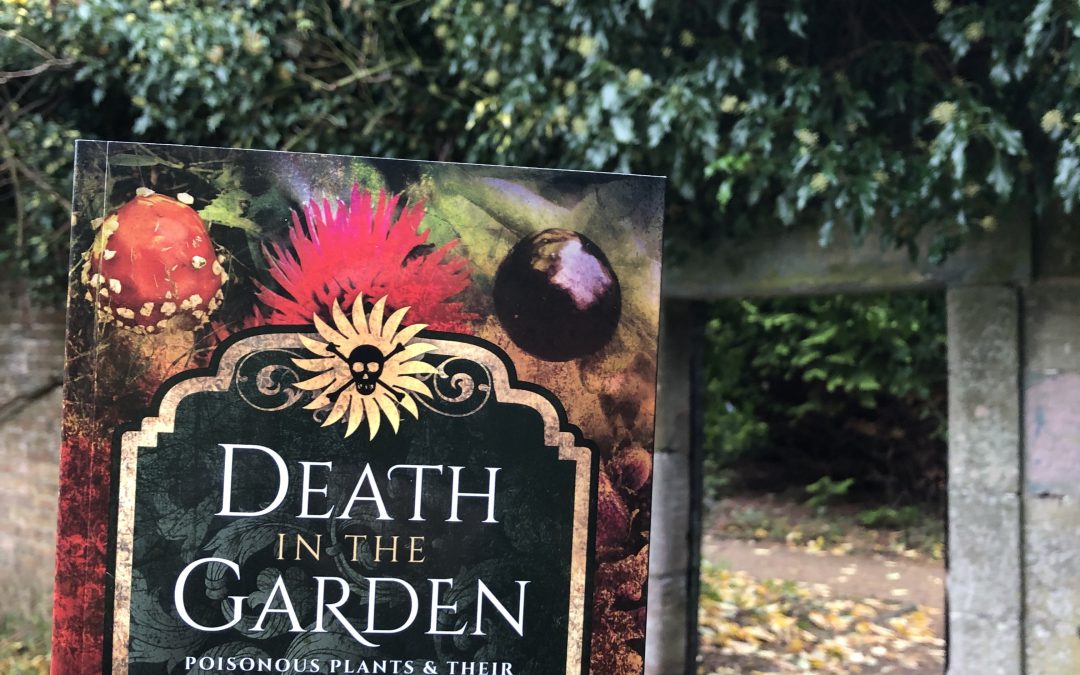My wife and I are both gardeners, and we have run our own gardening business since 2013. We know plants have the power to create an emotional and a physical response. Plants can remind us of loved ones who have passed, of special times or special people in our lives, or places we have visited. These emotions can be so strong they can also bring about a physical response; perhaps our eyes fill with tears of pain at the loss, or from joy at the happy memory, or perhaps the hairs on our arms or on the back of our neck can stand up and tingle. Being gardeners we are also aware some plants need a bit of caution when handling. Unpleasant physical reactions such as burning sap, stings, thorns, hairy leaves, pollen, and some other nasty surprises can occur, and we need to be mindful of plants that are capable of inflicting this type of harm.
The author of Death in the Garden, Michael Brown, is also a gardener. He’s been a gardener all his life, man and boy. He also has an education background in garden history, and has lectured and gives talks and demonstrations on the subject. The full title of the book is, ‘Death in the Garden – Poisonous Plants & their use Throughout History’. This is a big clue to the contents of the book. This book is not a complete list of all the poisonous plants you will find in your domestic garden at home. Such extensive lists are available on the internet, and they are fascinating to skim through. The main section of this book is indeed set out alphabetically, from Aquilegia to Yew, but it’s much more than a list. The book does not claim to list every single poisonous plant in the garden. Instead the author tells the stories of these plants within an historical background. As an example, most people would know a bright red mushroom with white spots on it may not be something they would want to eat. Even if they don’t know the name, Fly Agaric, they may know from either the look of it, or it’s associations with children’s stories and fables, that it could well be poisonous. But, they are less likely to know the Fly Agaric may well have been eaten by a particular group of Viking soldiers called Berserkers before they went into battle. Or, that mistaking the Fly Agaric mushroom for the Destroying Angel or Death Cap mushroom may be one of the last mistakes they will ever make, as consuming just half a mushroom cap of these latter nasties is likely to take your life. That’s the type of historical background to poisonous plants you will find in this book.



Please don’t let the Fly Agaric example lead you into thinking this book is all macabre and dark, it isn’t. In fact the author includes many humorous observations about plants and their uses. One of my favourites is, ‘Rhododendron can make you sick, and some say that’s just by looking at them’ 🤣. This is not a scary book. Actually the author puts many fears around certain plants into perspective by educating us about them. He does this in a chatty manner with lots of examples from ancient history to more modern history, and from the starting point of, ‘most plants are poisonous, what’s important is the dose’. This type of education and the sharing of knowledge is how we learn about poisonous plants.
Yes, people do die in the book. There are lots of examples of torture, murder and suicide by poisoning, and of people getting very sick, some by accident and some by deliberate acts. Throughout the book there are also historical references to these plants being used for medicine, alchemy, and witchcraft. Sometimes the plants were said to relieve various sicknesses and symptoms, and other times they probably did more harm than good.
The book begins by taking us way back to before words were written down. Somebody somewhere must have discovered the toxicity of these plants, and more than likely by accident. This knowledge would have been passed down by word of mouth or by observation. Once words were written down it was easier to classify plants and record their particular uses. The book discusses how the ancient Greeks and Romans recorded many uses for plants in their writings, myths and legends. The early sections of the book also take the reader through a timeline from shaman, witches, apothecaries, and herbalists, to early physicians, botanists and pharmacists. There is a look back to the Dark Ages, more modern history, and the Enlightenment. There is also a look at the ‘Dangers of the Potting Shed’ and how some Victorian practices put the health of gardeners at risk, and of Judges who would bring posies into the courtroom in the hope of preventing goal fever (i.e typhus) and hiding the stench of crowded courtrooms in less hygienic times. It really is fascinating how plants and our uses for them have evolved over time.






The history and writings at the beginning of the book are often referred back to as the reader progresses through the main alphabetical content. There are fabulous photographs of the plants on almost every double page. Keen gardeners will recognise lots of familiar garden favourites, such as Aquilegia, Bay, Bluebells, Daffodil, Hellebore, Foxglove, Lily of the Valley, Mistletoe, and Yew. There are others that will be less familiar like Cuckoo Pint, Petty Spurge, Thorn Apple and the Upas Tree. Other’s like Deadly Nightshade, Monkshood (aka Wolf’s Bane), Mandrake, and Strychnine may also be recognisable names for anyone who has some knowledge of folklore, fairy tales and murder mysteries.
The book concludes with recommendations of gardens to visit if you would like to see some of the poisonous plants featured in the book. I for one have put the Poison Garden at Alnwick Castle in Northumberland on my list of places to visit. The author also includes a final word about educating ourselves and our children about plants. The important point is to understand plants and what they are capable of, not to fear them. I agree. As someone once told me, ‘knowledge overcomes fear’.
I really enjoyed reading this book. I finished it more knowledgeable than I was when I started, and I was entertained at the same time. That’s a great way to learn and to relax. I would have no problems recommending this book to other gardeners, and also to those people who are looking for a gift that is a bit different, either for themselves or for a friend. Whether you are a gardener or not, I’m sure you will find this book a fascinating read.
Michael
Mr & Mrs Gardens Limited
All the photographs on this blog have been taken by us and are owned by Mr & Mrs Gardens Limited. They are not photographs from the book.



